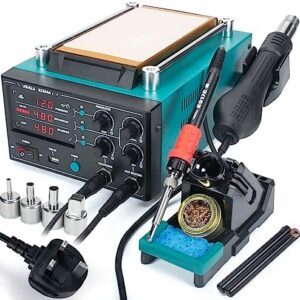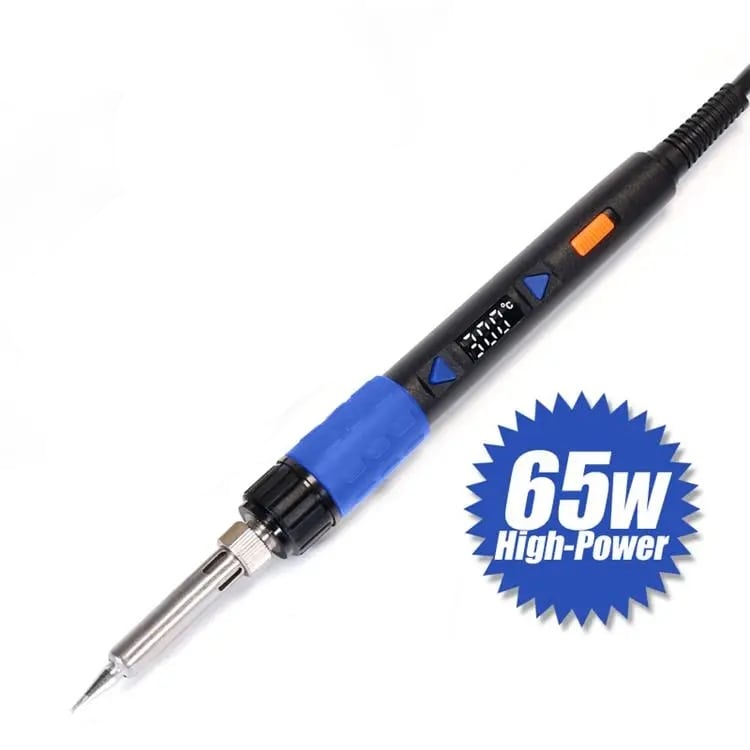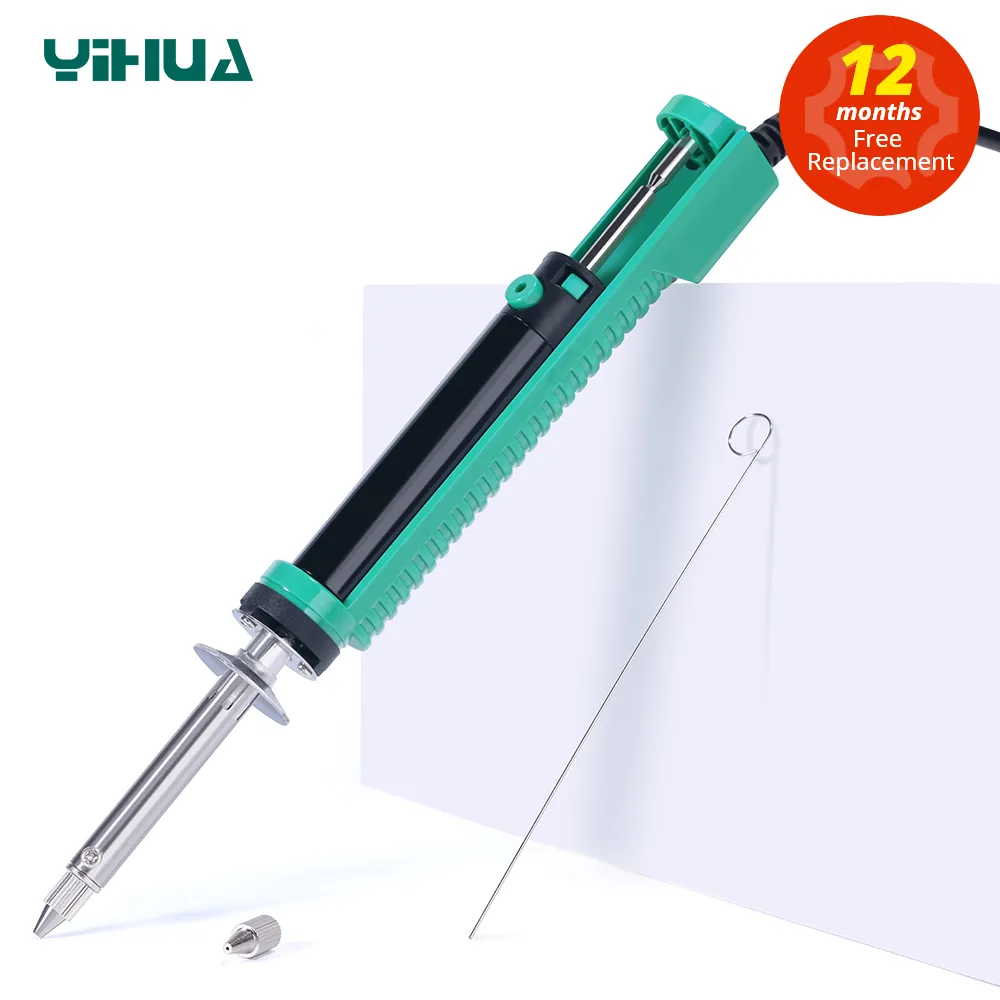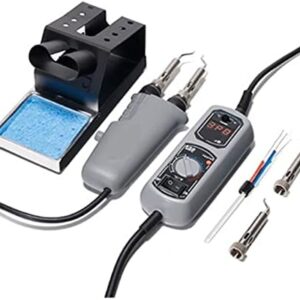What Is a Soldering Iron?
A soldering iron is a hand-held tool used in various soldering applications, designed to heat solder wire until it melts and forms a reliable electrical joint between workpieces. The invention of the soldering iron has transformed repair work across multiple industries, ensuring that electrical components are securely joined, thus enhancing the overall functionality of devices.
There are different types of soldering irons, including electric soldering irons and gas-powered versions, each with unique features suited for specific tasks. From temperature control capabilities to the use of interchangeable tips, understanding the different aspects of soldering irons is crucial for achieving optimal results.
How Does a Soldering Iron Work?
A soldering iron operates by using an electrical current to heat a heating element, which subsequently raises the temperature of the metal tip, typically made from a high thermal capacity material such as copper, enabling it to melt solder wire effectively.
When a soldering iron reaches its optimum temperature, it maintains thermal equilibrium, allowing for efficient heat transfer to the solder joint without damaging the components involved.
The design of the soldering iron, including its insulated handle and tip shapes, ensures safety and precision during the soldering process, making it an essential tool in various soldering applications.
What Are the Different Types of Soldering Irons?
There are several types of soldering irons available, each tailored for specific soldering applications and user preferences, including electric soldering irons, butane soldering irons, cordless soldering irons, and soldering guns, which vary in their heating methods and usability.
Electric soldering irons are the most common type, providing consistent temperature control, while butane soldering irons offer portability for outdoor use. Cordless options enhance mobility, making them ideal for repair work in hard-to-reach areas. Soldering guns are designed for high-volume production, delivering rapid heat and are often favoured in professional settings where speed is essential.
Electric Soldering Iron
An electric soldering iron is a versatile tool equipped with temperature control settings that allow users to adjust heat levels based on the specific soldering applications at hand, making it ideal for electronic projects and detailed repair work.
This critical feature not only enhances precision but also minimises the risk of damaging sensitive components, ensuring that even the most intricate jobs can be completed effectively. The advanced heating elements commonly found in these tools provide rapid heat-up times, enabling users to dive straight into their tasks without unnecessary delays.
- For hobbyists and professionals alike, an electric soldering iron proves invaluable for projects ranging from circuit board repairs to intricate jewellery making.
- The ability to maintain consistent temperatures means that soldering can be done with confidence, knowing the joint will endure.
Whether tackling DIY electronics or performing maintenance on household devices, this tool is a crucial ally, providing reliability and adaptability that every skilled craftsman or DIY enthusiast can appreciate.
Butane Soldering Iron
A butane soldering iron is a gas-powered tool that uses butane fuel to produce heat, offering portability and convenience, especially for outdoor soldering tasks where electricity may not be readily available. This remarkable adaptability allows users to tackle various projects in diverse environments, making it a popular choice for professionals and hobbyists alike.
These tools feature easy manual ignition, ensuring that you can start soldering quickly without the inconvenience of cords or heavy equipment. Their lightweight design makes them ideal for on-the-go repairs, whether you are in a workshop or out in the field.
Here are some advantages that make butane soldering irons stand out:
- Portability: With no need for a power socket, they can be used almost anywhere.
- Simplicity of Use: The manual ignition system allows for quick and easy preparation without additional setup.
- Quick Heating: They heat up rapidly compared to many electric alternatives, reducing downtime.
- Versatile Applications: Ideal for soldering, heat shrinking, and even for light-duty plumbing tasks.
When compared to electric soldering irons, butane models offer undeniable advantages in terms of mobility and versatility, making them suitable for both indoor projects and challenging outdoor conditions.
Cordless Soldering Iron
Cordless soldering irons are battery-powered devices designed for maximum mobility and convenience, enabling users to perform soldering tasks without being tethered to an electrical socket, making them ideal for fieldwork and home repairs.
These innovative tools are perfect for a variety of settings, whether you’re working on electronics in a cluttered workshop, performing repairs in hard-to-reach places, or simply in the comfort of your living room. The flexibility that cordless technology brings allows artisans and hobbyists to explore their craft without restrictions, boosting creativity and efficiency. With features such as rapid heating capabilities and adjustable temperatures, these devices cater to the distinct needs of different materials, ensuring optimal results.
- Portable and lightweight for easy transport
- Ideal for indoor and outdoor projects
- Enhanced safety with automatic shut-off features
The utility and convenience provided by battery-operated soldering irons can significantly enhance performance and satisfaction in any soldering endeavour.
Soldering Gun
A soldering gun is a specialised tool designed for high volume production, providing rapid heat to solder joints quickly, making it a preferred choice in industrial applications and fast-paced repair situations.
These versatile devices are characterised by their ability to reach operating temperatures within seconds, allowing for efficient and effective soldering, particularly in scenarios where time is crucial. When discussing the features of soldering guns, it is essential to note their dual-direction capabilities that enable both soldering and desoldering tasks easily.
- Rapid heating: This feature significantly reduces wait times, enhancing productivity.
- High-temperature stability: Ensures consistent solder quality throughout the job.
- Ergonomic design: Many models are designed with comfort in mind, minimising user fatigue during extended use.
In manufacturing settings, these tools are essential as they can handle a variety of materials, including wires and electronic components. By utilising a soldering gun, operators can achieve precision and speed, thus keeping production schedules on track while maintaining high-quality standards.
Temperature Controlled Soldering Iron
Temperature controlled soldering irons allow for user adjustment of heat settings, providing precise temperature management that is crucial for delicate soldering techniques and preventing damage to sensitive components.
When using a soldering iron with adjustable temperature settings, the user gains the ability to tailor the heat output according to the specific needs of each task. This personalised approach significantly enhances the quality of the work performed.
For instance, when working with:
- thin wires
- multilayer circuit boards
- and other temperature-sensitive materials
maintaining an optimal temperature prevents overheating, which can lead to failures. Different soldering techniques—such as wave soldering and reflow soldering—benefit from precise temperature control.
By incorporating proper heat management, the chances of cold joints, which significantly compromise electrical performance, are notably reduced.
Ultimately, possessing a temperature controlled soldering iron is essential for both hobbyists and professional technicians striving for excellence in their soldering endeavours.
What Are the Uses of a Soldering Iron?
Soldering irons have a wide range of uses across various fields, including electronics for circuit board soldering, jewellery making and repair, plumbing for pipe soldering, and even wood burning for artistic pyrography applications, showcasing their versatility and essential role in many professions.
Electronics and Circuit Board Soldering
In electronics, soldering irons are primarily used for circuit board soldering, where making solid solder joints with electrical solder is critical for maintaining the functionality of electronic devices.
To ensure the best outcomes, users should pay careful attention to several techniques and considerations while soldering. First, it is essential to select the right type of solder, as there are various options available, such as lead-based and lead-free solders. Each type has its own melting point and characteristics, impacting the quality of the solder joint.
- Temperature Control: Maintaining an appropriate temperature during soldering is crucial to prevent overheating components, which can lead to failure.
- Solder Joint Quality: High-quality solder joints should be smooth, shiny, and free from oxidation, ensuring good electrical connectivity.
- Cleaning: Proper cleaning of both the soldering iron tip and the components to be soldered helps enhance adhesion and reduces the risk of cold solder joints.
By mastering these techniques, hobbyists and professionals alike can create reliable and durable electronic connections that will withstand the test of time.
Jewelry Making and Repair
Soldering irons are widely utilised in jewellery making and repair, where precise soldering techniques are necessary to join metal components effectively and create durable pieces.
These tools play an essential role not only in crafting intricate designs but also in ensuring the longevity of the jewellery by forming robust connections. A solid understanding of soldering techniques is crucial for those diving into this art form. For instance, when soldering, it is important to choose the appropriate:
to achieve optimal results. The flux serves as a cleansing agent, preventing oxidation and enabling smoother solder flow, which is vital for a clean joint.
Jewellery artisans often work with various metals, including sterling silver, copper, and gold, each requiring different soldering approaches and flux types. Mastering the use of a soldering iron, alongside recognising the specific qualities of different metals, greatly enhances the quality and durability of the finished products.
Plumbing and Pipe Soldering
In plumbing, soldering irons are essential for pipe soldering, where they join metal pipes using solder wire and often require heat shrink tubing to provide insulation and protection for the joints.
The process of pipe soldering involves several crucial techniques that ensure durable and leak-proof connections. First, the ends of the pipes must be cleaned thoroughly to remove any oxidation or contaminants.
- Next, a suitable flux is applied to both surfaces, which helps the solder flow smoothly when heated.
- Once the assembly is ready, the soldering iron is carefully heated, typically to a temperature around 200°C to 260°C.
Plumbing professionals often use lead-free solder for approvals and safety standards, avoiding any toxic substances. After the solder melts, it should flow into the joint, creating a strong bond as it cools.
Using heat shrink tubing enhances the reliability of the connection by protecting it from moisture and corrosion, making this technique an essential part of modern plumbing.
Wood Burning and Engraving
Soldering irons are not only used in soldering but also find applications in wood burning and engraving, where they serve as hot tools for creating intricate designs on wood surfaces through pyrography.
The artistic possibilities using soldering irons extend far beyond simple burns; they encompass a wide range of techniques and styles that can transform a piece of wood into a stunning work of art. Various methods, including shading, stippling, and line work, can be explored when engaging in wood burning projects.
- Shading involves varying the pressure and angle of the soldering iron to achieve different tonal depths.
- Stippling creates texture through a series of small dots, enhancing the visual interest of the design.
- Line work focuses on using crisp, clean strokes to outline shapes or create complex patterns.
By mastering these techniques, artists can elevate their woodworking projects, making each piece uniquely expressive and visually appealing.
What Are the Safety Precautions for Using a Soldering Iron?
Using a soldering iron requires a set of safety precautions to minimise risks, including:
- wearing protective gear
- ensuring the work area is well-ventilated
- using a soldering station to securely hold the tool when not in use
These measures are essential to protect users from burns, exposure to fumes, and potential accidents that may arise during soldering applications.
Wear Protective Gear
Wearing protective gear while using a soldering iron is crucial for personal safety, including heat-resistant gloves, safety goggles, and aprons to shield against burns and harmful fumes.
Alongside these essentials, there are several other items that contribute to a safer soldering experience. Each piece of equipment plays a significant role in preventing potential injuries during the soldering process. For instance, anti-static wrist straps are instrumental in protecting sensitive electronic components from static electricity that could cause irreversible damage. A well-ventilated workspace is necessary to mitigate exposure to hazardous fumes emitted during soldering.
- Fume extractors: These devices help in reducing smoke and fumes, creating a healthier environment for the worker.
- Face shields: These can provide extra protection against splashes of molten solder.
- Long-sleeved shirts and closed-toe shoes: Wearing appropriate clothing can minimise skin exposure and provide an added layer of safety.
By integrating all these safety measures, one significantly decreases the risk of workplace injuries and ensures a safer, more productive soldering environment.
Work in a Well-Ventilated Area
Working in a well-ventilated area is essential when using a soldering iron to minimise exposure to harmful fumes generated during the soldering process, ensuring a safer environment for the user.
The significance of proper ventilation cannot be overstated, as it plays a critical role in maintaining health standards while engaging in soldering activities. When soldering, hazardous fumes can be released, containing toxic substances such as lead and flux, which can pose severe health risks if inhaled over time. It is vital for the operator to be aware of the potential dangers, making ventilation a priority rather than an option.
Creating a safe working environment can greatly reduce the likelihood of respiratory issues and other long-term health problems associated with inhalation of these fumes.
- Install fume extraction systems or use fume extractors to efficiently remove harmful air.
- Open windows or utilise fans to encourage airflow within the workspace.
- Consider using low-fume solder to further reduce exposure to harmful elements.
By incorporating these practices, the risks associated with soldering can be significantly diminished, leading to a healthier and more productive work atmosphere.
Use a Soldering Iron Stand
Using a soldering iron stand is crucial for safety and convenience, as it provides a secure place to rest the soldering iron when not in use, preventing accidental burns or damage to work surfaces.
To enhance safety further, these stands are typically designed to hold the soldering iron at the correct angle, minimising the risk of it rolling or tipping over. They often feature built-in sponge compartments for cleaning the iron, which is an important part of the soldering process. A user-friendly stand can greatly reduce the likelihood of mishaps, allowing individuals to focus on their work.
- Stability:
- Heat resistance:
- Accessibility:
By providing a designated space for the iron, the stand also promotes organisation within the workspace. This organisational benefit can significantly reduce workplace hazards, creating a safer environment for both beginners and experienced hobbyists alike.
Unplug When Not in Use
Always unplug the soldering iron when it is not in use to prevent accidental heating, which can lead to burns or fire hazards in the workspace.
Taking a moment to ensure that the device is safely stored away can significantly reduce the risk of unintended consequences. This simple action creates a safer work environment, where the likelihood of injury is minimised. Consider the benefits of developing a routine where the soldering iron is unplugged promptly after use, thus instilling a habit of safety in the workspace. Neglecting such precautions can result in serious accidents or equipment damage. Therefore, it is prudent to:
- Always double-check that the soldering iron is turned off.
- Store the device on a heat-resistant surface.
- Ensure that all nearby materials are not flammable.
By incorporating these safety practices, one not only protects themselves but also fosters a responsible approach to handling tools.
How to Choose the Right Soldering Iron for Your Needs?
Choosing the right soldering iron for your needs involves considering various factors, including the type of projects you will be working on, the need for adjustable temperature settings, and the comfort of the grip, while also comparing reviews and brands for the best options available.
Consider the Type of Projects You Will Be Working On
When selecting a soldering iron, it is vital to consider the type of projects you will be working on, as different applications may require specific features and capabilities, such as temperature control.
Certain project types demand unique approaches and tools. For instance,
- Electronics assembly projects typically benefit from a soldering iron equipped with adjustable heat settings, offering enhanced precision for working on sensitive components.
- For detailed work in jewellery making, a smaller tip is essential to apply solder accurately without affecting adjacent areas.
- In automotive repairs, a higher wattage soldering iron is often required to maintain heat on larger surfaces and thicker materials.
Choosing the right soldering iron tailored to specific needs can greatly improve the quality and efficiency of the work, making the selection process a pivotal step in the crafting journey. Understanding these distinctions helps ensure that the chosen soldering tool aligns with the demands of each unique project.
Look for Adjustable Temperature Settings
Looking for soldering irons with adjustable temperature settings is essential for achieving optimal results, as it allows for user adjustment to match the requirements of different soldering tasks, ensuring precision and preventing damage.
The significance of having the ability to customise the temperature cannot be overstated. Different materials require specific heat levels for effective soldering, which means that an adjustable temperature feature increases usability and versatility. This capability allows users to:
- Work on a wider variety of projects without damaging components.
- Enhance the quality of joints by selecting the appropriate heat for each task.
- Reduce the risk of overheating sensitive electronic parts.
By focusing on temperature control, users can achieve superior results, fostering creativity and precision in their work.
Check for Comfortable Grip and Lightweight Design
A comfortable grip and lightweight design are critical features to look for in a soldering iron, as they significantly enhance user experience and reduce fatigue during extended soldering sessions.
When selecting a soldering iron, it is essential to consider how these aspects can affect not just productivity but also the quality of work. A soldering iron with an ergonomic design allows for better control and precision, enabling the user to accomplish intricate tasks with ease. Incorporating lightweight materials minimises strain on the hands and wrists, which is particularly beneficial for those engaged in lengthy projects.
Enhancing comfort enhances performance, thereby encouraging prolonged concentration and skillful, accurate soldering. Many users find that their soldering techniques improve when they feel physically at ease during the process.
- Benefits of a Comfortable Grip:
- Reduced Muscle Fatigue
- Enhanced Precision
- Improved Control
With the right design features, users can enjoy a more enjoyable soldering experience, leading to better outcomes in their electronic projects.
Read Reviews and Compare Brands
Reading reviews and comparing brands is crucial when selecting a soldering iron, as it provides valuable insights into the performance, reliability, and durability of various options available on the market.
By taking the time to delve into user feedback and expert opinions, one can uncover essential details that might not be immediately apparent in product descriptions. For instance, the quality of the soldering tip can significantly impact the overall effectiveness and efficiency of the tool, affecting the final results of any project.
Understanding the differences in heat settings, ergonomics, and material quality can profoundly shape choices, ensuring that the selected tool aligns perfectly with specific needs.
- Look for models that offer adjustable temperatures.
- Consider the weight and grip for prolonged use.
- Investigate warranty and customer service support from different brands.
Thus, a thorough comparison not only guides one towards the most suitable soldering iron but also enables informed purchasing decisions, ultimately leading to greater satisfaction and success in all soldering endeavours.
Frequently Asked Questions
What is a soldering iron?
A soldering iron is a handheld tool used for melting and flowing solder onto metal joints to create a strong electrical connection. It is commonly used in electronics and jewellery making.
How does a soldering iron work?
A soldering iron works by heating up a metal tip to a high temperature, usually between 300-400 degrees Celsius. The solder, a low-melting-point metal alloy, is then melted onto the joint, creating a bond between the two pieces of metal.
What are the different types of soldering irons?
There are several types of soldering irons available, including pencil, gun, and station soldering irons. Pencil soldering irons have a pencil-like shape and are suitable for precise work, while gun soldering irons have a larger, trigger-like shape and are better for larger projects. Station soldering irons have a base unit that holds the iron and allows for temperature control.
What is the difference between a soldering iron and a soldering station?
A soldering iron is a standalone tool, while a soldering station consists of a base unit and a detachable soldering iron. The soldering station allows for better temperature control and often comes with additional features such as adjustable heat settings and digital displays.
How do I choose the right soldering iron for my needs?
When choosing a soldering iron, consider the size and type of project you will be working on, the required temperature for the materials you will be soldering, and any additional features you may need. It is also important to choose a soldering iron from a reputable brand to ensure quality and safety.
Why is it important to use a soldering iron safely?
Soldering irons can reach high temperatures and come into contact with hot metal, making safety precautions necessary. Always wear protective gear such as goggles and gloves, keep the iron away from flammable materials, and unplug the iron when not in use. It is also important to follow the manufacturer’s instructions and never touch the tip of the iron when it is hot.

 Our Reviews
Our Reviews



